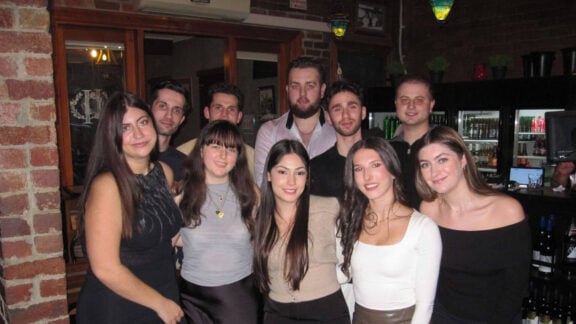The evidence from Australian sources is overwhelming: the fates of the indigenous Hellenic, Armenian and Assyrian peoples of Anatolia and eastern Thrace constitute a pre-determined plan aimed at their extermination.
This plan, which resulted in the deaths of millions, developed and implemented by the governments of the Ottoman Empire and its successor, the Turkish Republic, ‘was done with genocidal intent’, as the Executive Council of Australian Jewry declared in its 20 November 2013 statement.
As demonstrated by the evidence from Australian media, Australian prisoners-of-war, Australian humanitarian relief workers, and Australian scholars, Pontian history IS Victorian history; Pontian history IS Australian history.
Given these facts, our commemorations must be taken out into the broader Australian society. Enough moiroloi amongst ourselves; enough preaching to the converted. There remains a place for these, but they are not the end.
On 15 December 1914, The West Australian (Perth) reported that: ‘”Refugees from Armenia report that the position of 30,000 Christians at Erzeroum is terrible, as the Turks threaten to massacre them owing to their Russian sympathies. Many Armenians and Greeks suspected of espionage, were hanged without trial and their corpses were suspended from lamp-posts for weeks.”
Soon after, The Argus (Melbourne) reported that: “The Greek population from Maidos and Krithia on the Gallipoli Peninsula, have been transported to Panderma in a deplorable condition” (26 June 1915).
In an article titled ‘Atrocities in Smyrna’, The West Australian (9 September 1915, page 7) told its readers that “terror reigns in Smyrna, from where the Christians are being forcibly removed to the interior. Bashi Bazouks are plundering without restraint, apparently aiming at the extermination of the Greek population in Smyrna.”
These are but three fragments of the large volume of Australian media sources on the Genocides of the Hellenes, Armenians and Assyrians. They illustrate some key points:
1. The Australian media saw these are important enough to publish;
2. The genocidal plans were aimed at ALL Hellenes;
3. These reports prompted a massive response of donated relief aid.
4. The Australian responses to the Genocides make them as much part of the Australian story as Phar Lap, Kokoda and the Green Bans.
One of the most striking anecdotes was the following: The Argus reported on 19 October 1922 that the Anglican Archbishop of Melbourne, Dr Harrington Lees, recently took part in a remarkable ceremony. On Prince’s Pier, Port Melbourne, at the invitation of the Armenian Relief Fund committee, he blessed the consignment of flour and produce, which was being shipped to the Dardanelles, the Hellespont.
With half the original cargo left with the Australasian Orphanage at Antelias (now in the northern suburbs of Beirut, Lebanon), the Hobson’s Bay proceeded to Constantinople, where it was met by the local Near East Relief Director, Dr Jacquith.
As Wirt later recalled, Jacquith said: “Do you remember St. Paul’s vision and the cry from Macedonia, ‘Come over and help us’? You are no saint and probably do not resemble St. Paul in the least – except perhaps in stature – but here is a message for you. It came in the same way St. Paul’s did – by wireless”. And he handed me a radiogram. It was indeed the same cry.
The radiogram was from a Near East Relief (NER) post at Alexandroupolis in western Thrace: ‘Ten thousand people driven from Eastern Thrace are here, starving to death. They have been overlooked in the food distribution. Some are dead, many are dying. Can you send flour?” Jacquith informed his colleague that the local NER had already “stripped our warehouses and taken from our orphans to provide for the new outbreak at Smyrna. Have you brought anything that can be used in this emergency in Macedonia?”
Wirt responded positively, for Hobson’s Bay still had 4,000 bags of Australian flour stowed away, “given for the express purpose of meeting some such emergency”. As Wirt later recorded: “Time was precious; moments meant lives”. Within a few hours, the flour had been transferred to a steamer and was on its way.
It passed tragic Gallipoli, where many brave Anzacs from Australia and New Zealand had laid down their young lives, face to the foe. And now the unhappy victims of this same foe were to be fed with bread from their homeland, as if to complete the work for which they died. Anzac bread! (Loyal Lincoln Wirt The world is my parish Los Angeles: Warren F. Lewis 1951, p. 219)
The Parliaments of South Australia and New South Wales have both unanimously adopted resolutions of recognition of the Genocides of the indigenous Hellenic, Armenian and Assyrian peoples of Anatolia and eastern Thrace. As testified by the motions themselves and the speeches on the floor of the respective chambers of parliament, recognition of the Genocides as Australian history was a key part of these successes.
Leaving here after this afternoon’s address, please take away three points: Hellenic Genocide history IS Victorian history; Hellenic Genocide history IS Australian history; only our efforts will secure Hellenic Genocide history’s place in the Australian story.
*This is an address by Dr Panayiotis Diamadis, Lecturer of Genocide Studies, University of Technology Sydney, to the Annual Commemoration of the Genocide of the Hellenes of Pontos 1916-1924 at the Pontian Community, Melbourne, on Sunday 18 May 2014








